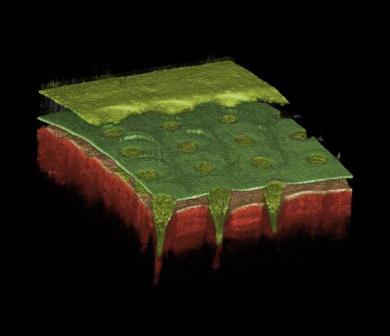Optical coherence tomography shows effect of drug delivery by microneedles
21 Oct 2010
Researchers at Queen’s University Belfast have studied the performance of microneedles for drug delivery using an optical coherence tomography system from Michelson Diagnostics (MDL).
The research, published in the Journal of Controlled Release [1], shows how the MDL VivoSight OCT system was used to directly image the microneedles penetrating the skin, and how the results were used to evaluate the effects of microneedle spacing and force of application.

OCT image of microneedles penetrating the skin
Drug delivery systems using microneedle arrays are of great interest to pharmaceutical companies who would like to alleviate the discomfort of the standard hypodermic needle with an-easy-to-administer, painless drug delivery method. Many companies are developing microneedle technology, targeting a slice of the $18bn drug delivery device market. The microneedles range from hollow or coated steel arrays to biodegradable polymer needles that dissolve once injected.
Microneedle developers aim to design devices that are effective at penetrating the surface layer of skin, known as the stratum corneum, to deliver drugs to the dermis, whilst being short and narrow enough to avoid stimulating the dermal nerves and causing discomfort. It is important to understand how a change in microneedle design and application method affects the device performance.
According to the authors of the paper, “The successful use of OCT in this study could prove to be a key development for polymeric micro-needle research, accelerating their commercial exploitation.”
“The VivoSight system is a unique tool for transdermal drug delivery development. It is the only clinical technology that can image the needles in situ, in real time,” said Dr Daniel Woods, Senior Imaging Scientist at Michelson Diagnostics Ltd., adding “The high resolution and extended penetration depth of VivoSight mean that researchers can really understand how the needles interact with the skin.”
Reference
1. Ryan F. Donnelly, Martin J. Garland, Desmond I.J. Morrow, Katarzyna Migalska, Thakur Raghu Raj Singh, Rita Majithiya, A. David Woolfson. Optical coherence tomography is a valuable tool in the study of the effects of microneedle geometry on skin penetration characteristics and in-skin dissolution. Journal of Controlled Release. DOI:10.1016/j.jconrel.2010.08.008